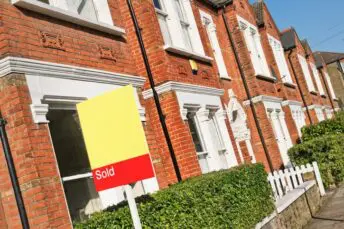House Price Watch Aug 2023
Higher mortgage rates are weighing on market activity and house prices. Demand is a third lower than the five year average, transactions are at a ten year low and house price growth is at its lowest since 2009. The impact of mortgage rates is clear on transaction volumes; those involving a mortgage have fallen sharply, while cash purchases have held steady. Housing affordability remains the main barrier to sales and the market will continue to rebalance until buyers are comfortable with the highest mortgage costs in 15 years.
What’s happening nationally
House prices are down on average (-0.7%) in the past month and -3.1% in the past year.
Land Registry reporting July figures noted a slight increase in house prices over the past month, while the other indices reporting August figures recorded a fall in house prices. All the indices indicate a slowing of the annual rate of growth with Nationwide, Halifax and Rightmove showing a fall in house prices over the past year.
Indices based on:
Land Registry – registered property transactions in July.
Nationwide & Halifax – mortgage valuations in August.
Rightmove – asking prices posted on Rightmove in August.
*Rightmove is not included in the index average as the basis for its index is different (asking price vs agreed sale price)
| Index reports: | Monthly change | Annual change |
|---|---|---|
| Land registry | +0.5% | +0.6% |
| Nationwide | -0.8% | -5.3% |
| Halifax | -1.9% | -4.6% |
| Rightmove | -1.9% | -0.1% |
| Average change | -0.7% | -3.1% |
House prices in your area
House prices fluctuated over the past month — up in some areas and down in others. However, the annual rate of house price growth continues to slow in all areas and is in negative territory in the South West (-1.0%), London (-0.8%) and Wales (-0.1%).
Average house prices remain highest in London (£534K) and lowest in the North East (£164K).
House price growth is slightly higher for properties that are detached (+2.2%) or semi detached (+1.0%) and slightly lower for properties that are terraced (-0.3%) or flats/ maisonettes (-1.0%) according to July Land Registry data.
| UK Region | Average price £ | Monthly change | Annual change |
|---|---|---|---|
| England | |||
| Nothern Ireland | |||
| Scotland | |||
| Wales | |||
| North West | |||
| Yorkshire and The Humber | |||
| North East | |||
| West Midlands | |||
| East Midlands | |||
| South West | |||
| East of England | |||
| South East | |||
| London |
| UK City | Average price | Annual change |
|---|---|---|
Market Monitor
There were 86K transactions in July, steady with June 2023, 16% lower than July 2022. 86K transactions is amongst the lowest we have seen in the last decade.
Cash buyer sales are expected to hold in line with 2022 while mortgage backed sales are likely to be 28% lower as higher mortgage rates impact demand (Zoopla data).
Demand continues to fall as do new instructions from sellers this month. Average stock per agent is up month on month.
Time to sell is steady at approximately 55 days, slower than the average of 50 days over the last 12 months.
How busy is the market?
- Not busy
- Normal
- Very busy
- Transactions steady in July, but remain at ten year low
- Total transactions in July 86K
- +0.8% from last month
- -16% from July last year
Homes for sale vs homebuyers
- Good availability of homes
- Normal
- Shortage of homes
- Buyer enquiries continue to fall(-47% RICS); demand continues to fall
- Seller enquiries down (-26% RICS); weakest instructions since Sept 2021
- Average stock per agent 53; up from 52 last month (incl under offer/ Sold STC Rightmove)
Average speed of sale
- Fast
- Normal
- Slow
- 55 days to find a buyer, steady (12 month average 50 days Rightmove)
What the experts say
Rightmove - agent's view

“Average new seller asking prices fall by 1.9%, the biggest fall in August since 2018, as summer sellers tempt buyers preoccupied by holidays, inflation, and the highest Base Rate since 2008. Although, average prices are still 19% higher than in the pre-pandemic market of August 2019. The number of sales being agreed is now 15% lower than the more normal 2019, although the first-time buyer sector is holding up better and down by only 10%, due in part to record rents and the scarcity of rental property. No glut of homes for sale as the number of available properties is still 10% lower than at this time in 2019, with agents reporting that realistically-priced homes in popular areas are tempting buyers who don’t want to miss out.”
Nationwide

“August saw a further softening in the annual rate of house price growth, the weakest rate since July 2009. The softening is not surprising, given the extent of the rise in borrowing costs in recent months, which has resulted in activity in the housing market running well below pre-pandemic levels. The composition of transactions reveals cash purchases, though down from 2021 highs, have been remarkably resilient, while purchases involving a mortgage have slowed much more sharply. Home mover completions (with a mortgage) in the first half of 2023 were 33% lower than 2019 levels, first-time buyer numbers were c.25% lower. Buy-to-let purchases involving a mortgage were nearly 30% below pre-pandemic levels. By contrast, cash purchases were actually up 2%. The relative weakness of mortgage activity reflects mounting affordability pressures as a result of the sharp rise in mortgage rates since last autumn. For example, a first-time buyer earning the average wage and buying a typical first-time buyer property with a 20% deposit would now see their monthly mortgage payment absorb over 40% of their take-home pay (with a mortgage rate of 6%) – well above the long run average of c.29%.”
Halifax

“UK house prices fell again in August. The average home is back to the level seen at the start of last year. On an annual basis prices fell by -4.6%, the biggest year-on-year decrease since 2009, though it should be noted that this is relative to the record-high property prices seen last summer. It’s fair to say that house prices have proven more resilient than expected so far this year, despite higher interest rates weighing on buyer demand. However, there is always a lag-effect where rate increases are concerned, and we may now be seeing a greater impact from higher mortgage costs flowing through to house prices. Increased volatility month-to-month is also to be expected when activity levels are lower, though overall the pace of decline remains in line with our outlook for the year as a whole. The market will continue to rebalance until it finds an equilibrium where buyers are comfortable with mortgage costs in a higher range than seen over the previous 15 years.”
Zoopla (Hometrack)

“The housing market continues to adjust to higher mortgage rates and cost-of-living pressures with weaker demand, fewer sales and very low house price growth. Demand for homes is running 34% lower than the average compared to the same period in last 5 years (2018-2022). Cash buyer sales are expected to hold in line with 2022 while mortgage backed sales are likely to be 28% lower as higher rates impact demand. While house price growth has slowed rapidly over the last year, the primary impact of higher mortgage rates has been lower sales volumes. Our data on the number of homes being sold ‘subject to contract’ over the year to date shows the market is still on track for 1m sales completions in 2023. This will be 21% down on 2022 levels and the lowest number of sales since 2012. Housing affordability remains the primary barrier to more sales – both the level of house prices and the cost of mortgage repayments.”
RICS

“The August 2023 RICS UK Residential Survey results again portray a downbeat market backdrop, as buyer demand and agreed sales continue to fall sharply in the face of higher mortgage rates. Alongside this weakness in activity, house prices remain on a downward trajectory, with the latest survey feedback pointing to an acceleration in the pace of decline through August.”




